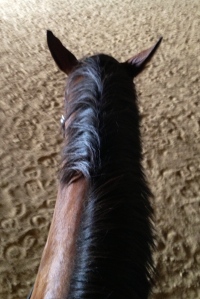The big toe and the collarbone
July 24, 2013 1 Comment
Within the last week or so my knee has finally stopped hurting. I’ve been in physical therapy for an IT band injury since March, and I’m happy to report it’s finally paying off. The therapy of late has really focused on hip and core strength. Of course, this is good for my riding or at least I believe will be. However, despite the improvements in my right leg, I still need to work on evening up my strength and flexibility on both sides. During this time of rebuilding and reconditioning myself, the unevenness in my strength has had a pronounced effect on my riding. If I ride in my default, unbalanced position, the horse will stagger off to the left. While this is less pronounced on Derby, when I had a lesson on Christy’s horse Austin, who is much more sensitive, we were drawn to the middle of the arena as if by a magnet.
Christy is having me remedy this situation a few ways. First and foremost, she is absolutely requiring me to ride the horse forward. Secondly, she’s focusing on having me use what we’re now calling my “everything muscle,” — which is really another way of saying riding with my body fully engaged. The checklist I’ve been running through in my head (because this is not yet have it and I have to remind myself continually) goes something like this: “Head straight, shoulders back, chest lifted, hips even, core engaged, no, core really engaged, hips open, legs long, calf draping and toes up.” Rinse and repeat.
Remembering to keep my toes up rather than my heels down actually has a profound effect on my leg, we’ve discovered. For me at least, when I’m thinking toes up, I engage my whole leg, especially my quadriceps and hip flexors, which also has the effect of opening my hips. We discovered this one night when rather hilariously Christie asked me what adjustment I made when I managed to improve my position, you done to and I told her I flexed my big toes. Sounds silly, but you try it next time you’re in the saddle. The act of flexing your toes upward, rather than just letting gravity pull your heels down, engages a different range of muscles. This is a happy accident, because for me, these are muscles I needed to engage, and I didn’t realize I was failing to do so.
Tonight, we discovered the connection that exists between my collarbone and my big toes. I have a bad habit of slouching through the waist, especially slumping to one side. It’s really hard to ride with decent contact when your waist is engaged, and my solution to this problem, instead of writing correctly, tends to be too harsh word and pull back with my hands. Christy noticed that recently I’ve been really reverting to this position when I go through turns. So she reminded me to turn from the waist, and basically keep my head, hands and shoulders aligned.
“Put your collarbone in the direction you want to go,” she insisted. “Make side reins out of your hands, and close your fingers, keep your hands in front of you and not pulling!”
As most of you know that this elementary exercise results in the rider using the outside ring correctly and softening the inside rain and generally speaking good things happen. Such was the case for me. However, there was another benefit as well. Christy noticed that my posture kept improving as I worked through the exercises while deliberately holding my rein and leading with my collarbones. Simply put, you cannot turn from the waist, and keep your head, shoulders and hands all aligned if you are slumped through your midsection. Additionally, for whatever reason, probably because I’m focused on the collarbones, I was keeping my chest open too, which also helped me keep my shoulders back. Another problem solved!
IT band exercises
I have long promised but failed to deliver to a number of you an outline of the exercises that I’ve been doing physical therapy for my IT band. If you don’t do anything to actively strengthen those important outside muscles, and the things they are attached to, I encourage you to do start doing so forthwith. An IT band injury is really painful and takes forever to heal – I strongly recommend avoiding it at all costs!
Exercises that the physical therapist is having me focus on include:
- Side planks – Holding for 30 seconds and also going up and down repeatedly in sets of 10
- Regular planks
- Clamshells: plan your side bend your knees and align yourself shoulder hips heal. Keeping your feet together open your legs leading with the knee that is on top. For extra resistance put a rubber band around your knees.
- Sidesteps: Put the rubber resistance band around your ankles. Do a partial squat like you’re in ready position for playing tennis. Keeping your knees bent, move laterally. This is best done down a long hallway or in your basement where no one is watching. If you’re doing it correctly, in addition to your adductors on the outside of your leading leg, you’ll also feel your gluteus medius working on that side too. Do 10-15 steps each direction, and repeat.
Here are some links with additional exercises and details, if you’re interested.
http://www.sportsinjuryclinic.net/sport-injuries/knee-pain/iliotibial-band-syndrome/strengthening-iliotibial-band-syndrome (see the 7 exercise routine the author developed – this is very similar to what one of my PT sessions looks like (though I do a bit more core, by adding the planks.)


Interesting. I am in PT for twisted vertebrae and I am doing the same exercises, plus of course a boatload more. They must be good for you all the way around!